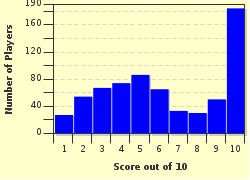Quiz Answer Key and Fun Facts
1. The outcome of the epic Persian - Greek naval battle at Salamis was determined when the Greek commander Themistocles was able to use his experience with the local weather as a sort of 'home field advantage' Specifically what weather phenomenon was key in thwarting Xerxes' larger Persian fleet?
2. In the 13th century, Kublai Khan, leader of the Mongol Empire, set about
the conquest of Japan, but was defeated by two monsoons which gave rise to what Japanese word?
3. The defeat of the Spanish Armada by the smaller and outgunned English navy in 1588 has customarily been attributed solely to September weather conditions in the North Sea. In fact, the weather was merely the final blow in a clever defensive that began with fire barges - which forced the Spaniards to cut themselves free from their anchors. What English term was coined to describe the victory?
4. During the period of severe weather known as 'The Little Ice Age' (1560 - 1700), human behavior was pushed to the limit by inexplicable climate changes that affected all aspects of life. Which of the following behaviors was most commonly associated with 'climate panic'?
5. The Battle of Long Island was considered a defeat for George Washington's Continental Army. Trapped on the west end of the island by British Generals Cornwallis and Clinton, what weather phenomenon aided the Americans in escaping to continue the resistance?
6. 'It was the best of times, it was the worst of times,' - so Dickens describes France at the time of the revolution in his novel 'A Tale of Two Cities'. With an economy already reeling from a spring drought in 1788, what bad turn of the weather triggered food riots and ultimately the overthrow of the monarchy?
7. More than a million acres burned and over two thousand five hundred lives were lost in what famous Upper Midwestern fire on October 8, 1871?
8. John Steinbeck's novel "The Grapes of Wrath" chronicles a family dealing with the hardship caused by dust storms during the 1930s in middle America. Which of the following was NOT a cause of these dust storms?
9. The Russian city of Stalingrad was besieged by the German army from August, 1942 to February, 1943. How did the weather play a factor in the outcome of the siege?
10. On August 6th and 9th, 1945, the United States dropped atomic bombs on Hiroshima and Nagasaki, Japan, effectively bringing down the curtain on Japanese aggression. Only Hiroshima, however, was a primary target. What weather spared which city ticketed for total destruction that day?
Source: Author
sidnobls
This quiz was reviewed by FunTrivia editor
Exit10 before going online.
Any errors found in FunTrivia content are routinely corrected through our feedback system.


